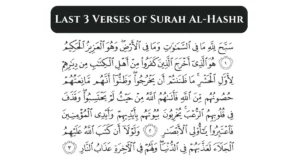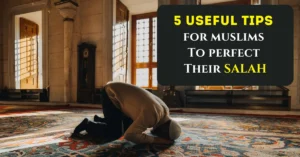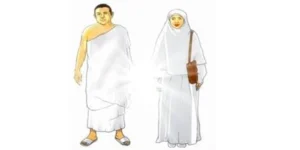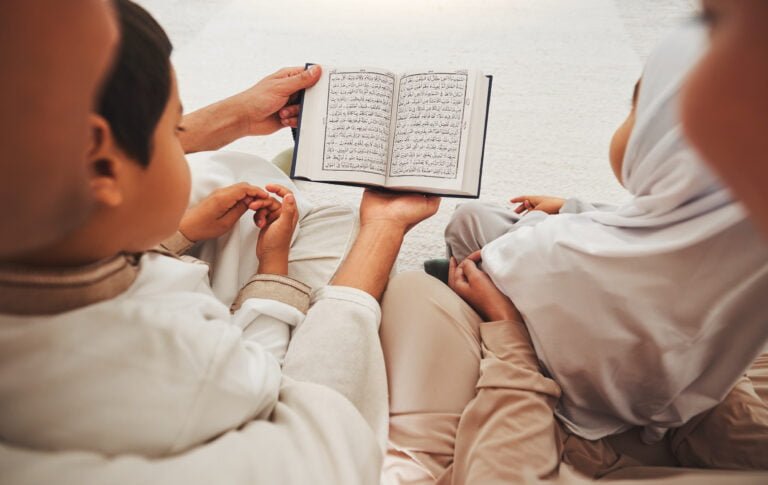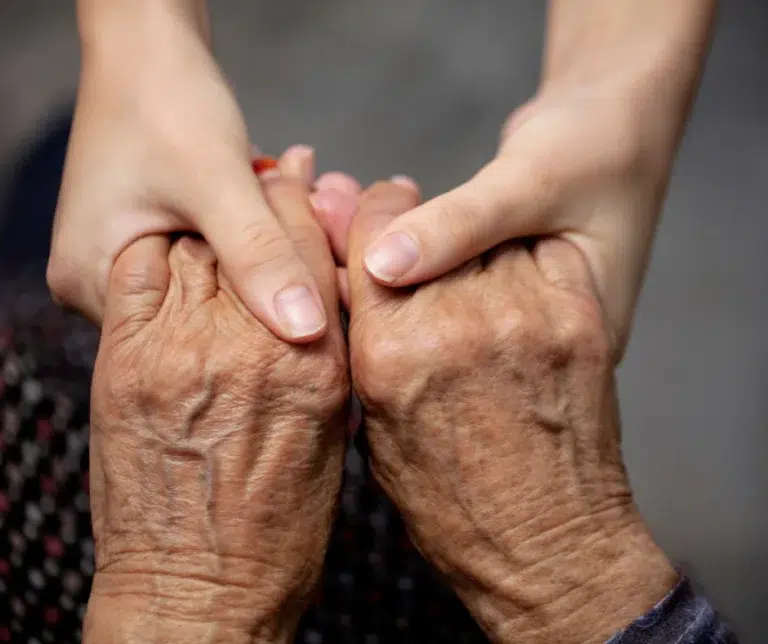What is the Kiswa?
The Kiswa is the cloth that covers the Kaaba, Islam’s most holy site, located in the Masjid al-Haram in Mecca, Saudi Arabia. They designate this respected black silk cloth with verses from the Quran in gold and silver thread.
The Kaaba cloth is not just a protective cover; it symbolizes the unity and continuity of the Islamic faith. Its presence on the Kaaba upholds the holiness of the site and the collective identity of the Muslim Ummah (community).
The Kaaba is Islam’s holiest site, symbolizing unity, devotion, and the Oneness of Allah (SWT). To get more information about the Kaaba, visit this post: The Kaaba: History and Significance in Islam.
Inside Masjid Al Haram in Makkah, a unique and pleasant scent begins to rise near the Holy Kaaba—a fragrance that might surprise visitors. This powerful and thick perfume becomes more prominent when the House of Allah (SWT) is close. The fragrance originates from the ornate silk clothing covering the Holy Kaaba.
What is Written on the Kiswa?
They decorate the cover of the Kaaba with beautiful and detailed calligraphy, including various Quranic verses, Islamic phrases, and prayers. Here are some of the elements they commonly write on the Kiswa.
Tawheed
They prominently feature the Declaration of Faith.

To learn more about Shahada in Islam, please feel free to visit this blog post: Tawheed: The First Pillar of Islam.
Quranic Verses
They highlight the most prominent inscription with Quranic verses in gold and silver thread. These verses are not random selections but focus on themes of God’s oneness, mercy, and guidance.
- Verses from Surah Al-Ikhlas (Chapter 112)
- Surah Al-Fatiha (Chapter 1)
- Surah Al-Hashr 2:127
- Ayat al-Kursi (2:255)
Ayat ul Kursi is a powerful Quranic verse that provides spiritual protection, peace, and blessings. For more information, visit this blog post: Ayat ul Kursi—And its Benefits.
Tasbih
The phrases glorifying Allah (SWT) are also prevalent. Some of these are:
- Subhan Allah (Glory be to Allah)
- Alhamdulillah (Praise be to Allah)
- La ilaha illallah (There is no god but Allah)
- Allahu Akbar (Allah is the Greatest)
Prayers for the Prophet Muhammad (SAW)
Prayers and blessings for the Prophet Muhammad (SAW) are also written, such as “Allahumma salli ‘ala Muhammad” (O Allah, send blessings upon Muhammad).
The writing on the Kaaba cloth is carefully designed for beautiful and spiritual impact. Skilled artisans use traditional techniques to create detailed needlework, resulting in a glorious piece of religious art.
Parts of the Kiswa
The cloth of the Kaaba is composed of different parts, each with its unique features and significance. Here are the primary parts of the Kiswa:
- Overall Fabric: As mentioned earlier, the main body of the kaaba cloth is made of black silk and decorated with gold and silver calligraphy. The black silk of the Kiswa signifies equality and unity. In Islam, all believers stand equal before God, regardless of social status or ethnicity. The black color reflects this principle, reminding pilgrims of the shared foundation of their faith.
- Al-Hizam (The Belt): This band runs around the top third of the Kiswa. It is approximately 47 meters long and 95 centimeters wide. They serve as a constant reminder to pilgrims performing tawaf (circumambulation) of the Kaaba about the Uthmah, grandeur, and power of Allah (SWT).
- The Curtain of the Door (Burqa): The Burqa is the visible exterior door covering the Kaaba, intricately decorated with Quranic verses and religious phrases.
- The Sitara (Inner Curtain): Inside the Kaaba, there is an inner curtain known as the Sitara. This part is less visible to the public, as only a few people are allowed inside.
- Corner Coverings (Arkan): These are the specific areas of the Kiswa that cover the four corners of the Kaaba. Each corner holds a significant place in Islamic tradition, with the Black Stone (Hajar al-Aswad) being the most notable.
- The Base Covering: The bottom portion of the Kiswa, around the base of the Kaaba, is designed to be raised during the Hajj season to prevent damage from pilgrims touching and jerking at the cloth. This part is usually plain and more stable compared to the upper sections.
The Kiswa Through Time
The Kaaba has a great history that covers different periods, reflecting the cultural and political changes within the Islamic world. Initially, it was a symbol of respect, with various crews contributing to its tradition before the beginning of Islam.
During the Islamic era, starting with Prophet Muhammad (SAW), they standardized the Kiswa as a black silk cloth embroidered with gold and silver thread featuring Quranic verses.
Under the caliphates, the Kaaba cover underwent significant changes. The third Caliph, Hazrat Umar (RA), was the first to send a white linen Kiswa from Egypt, known for its high-quality textiles.
The Abbasid era introduced Egyptian tiraz cloth, and the tradition of changing the Kiswa became more organized, with specialized facilities appearing to handle complex tasks. The color of the Kiswa also changed, with red, green, and finally, black textiles becoming the standard during the rule of Abbasid Caliph Al-Nassir.
The Kaaba Without the Kiswa
When the Kaaba is without its Kiswa, it shows its simple yet profound architectural design. The Kaaba is a cuboid granite structure standing approximately 13.1 meters (43 feet) high, with sides measuring about 11.03 meters (36.2 feet) by 12.86 meters (42.2 feet). Its walls are constructed from large, smooth, simple stones.
Incidents of Fire and Damage:
- The Year of the Elephant (570 CE): In the Year of the Elephant, Abraha, the Abyssinian governor of Yemen, tried to destroy the Kaaba with an army that included elephants. Accounts describe the Kaaba being uncovered and in a state of destruction. According to Islamic sources, Allah (SWT) miraculously stopped this attack by sending birds that dropped stones on the invaders.
- 683 CE (Siege of Mecca): In 683 CE, during the Second Fitna, a civil war among Muslims, the Umayyad army set fire to the Kaaba, damaging it. This event, called the Siege of Mecca, led to the burning of the Kiswa, revealing its structure.
- 1629 CE: During this period, the Kaaba was indeed without its Kiswa, as the structure was being rebuilt. These events underscore the Kaaba’s central role in Islamic history and its significance as a symbol of faith.
- Annual Replacement of the Kiswa: The Kiswa, which covers the Kaaba, is replaced with a new one annually during the Islamic month of Dhu al-Hijjah. This replacement is accompanied by a specific ceremony, during which the Kaaba stands uncovered for a brief period.
- Cleaning and Maintenance: Additionally, the Kaaba undergoes periodic cleaning and maintenance, during which the Kiswa may be partially or entirely removed to ensure the structure’s upkeep.
Changing of the Kaaba Cloth
The changing of the Kaaba cloth is a significant event in the Islamic calendar. This ceremony takes place on the 9th of Dhu al-Hijjah, the day of Arafah, which is an important day during the Hajj pilgrimage. The event holds great symbolism as it signifies holiness and respect for the Kaaba.
The Making of the Kiswa
The cloth of Kaaba is produced at the King Abdulaziz Complex for Manufacturing the Kaaba’s Kiswa, commonly referred to as the Dar Al-Kiswa factory. This factory is located in Mecca, Saudi Arabia, just a few kilometers from the Masjid al-Haram. The Kiswa Factory in Makkah, established in 1926, signifies the importance of this tradition. Over 200 skilled artisans work year-round to produce the Kiswa.
Before establishing the Dar Al-Kiswa factory, they traditionally made the Kiswa from silk in various locations throughout Islamic history, including Egypt and even Italy.
For looking the location of the kiswa factory, visit this: www.visitsaudi.com.
Process of Preparing the Kaaba Cover
The creation of the Kiswa involves meticulous attention to detail at every stage. Here’s a closer look at the process involved in preparing the Kaaba cover:
Dyeing
The making of the Kaaba cloth begins with the preparation of the raw silk.
- Cleaning: They thoroughly clean the raw silk to remove impurities.
- Dyeing: The clean silk is dye with black using high-quality dyes. This process ensures that the color is deep and uniform.
Weaving
Once dyed, the silk threads are woven into the fabric using both traditional methods and modern technology to ensure the highest quality.
- Traditional Weaving: Skilled craftspeople use fabric looms to create elaborate patterns and confirm the strength and lastingness of the fabric.
- Modern Weaving: Automated looms are also used to quick the process and maintain stability. These looms are programmed to weave detailed designs and calligraphy into the fabric.
Printing
Printing the Quranic verses and designs onto silk fabric is a crucial step in the creation of Kaaba cloth.
- Screen Printing: This traditional method involves creating patterns for each design and verse, which are then used to apply the designs onto the fabric using special inks.
- Digital Printing: Advanced digital printing techniques are also used to ensure the exactness and clarity of the designs and calligraphy.
Embroidery
The Kiswa’s most unique feature is its gold and silver needlework, which adds a touch of refinement.
- Materials: The embroidery uses high-quality gold and silver threads, which are made from a combination of silk and metallic fibers.
- Techniques and Craftsmanship Involved: The embroidery process requires highly skilled craftspeople and may take several months to complete, demonstrating dedication and expertise.
Preparation
Once the needlework is complete, the final preparation stages begin.
- Inspection and Quality Control: The completed Kaaba cloth undergoes strict inspections to ensure that there are no faults and that the quality is impeccable.
- Assembly: The different parts of the Kiswa are assembled and stitched together.
- Transportation: The Kiswa is then carefully packed and transported to the Masjid al-Haram.
Kiswa Cloth Price
The Kaaba cloth’s cover is significant due to the careful craftsmanship, high-quality materials, and complex needlework involved. On average, the cost of producing the Kiswa is calculated to be around 20 million Saudi Riyals (approximately $5.3 million USD). This cost covers the high-quality silk fabric, gold and silver threads, and the skilled labor required to create the decorated and religious covering.
Frequently Asked Questions (FAQs)
According to Islamic tradition and historical records, the first person to cover the Kaaba with a cloth was believed to be Adnan, an ancestor of the Prophet Muhammad (SAW). Adnan is considered a key figure in the lineage of the Quraysh Crew.
If you are interested in obtaining a piece of the Ghilf e Kaaba, it is essential to note that it is typically not available for commercial purchase. Your best course of action would be to contact the General Presidency for the Affairs of the Two Holy Mosques or other official Islamic organizations that might have the authority to distribute these sacred pieces.
The old Kiswa is carefully removed and cut into pieces. These pieces are then distributed as gifts to celebrities, religious leaders, and influential figures around the world.
The Kiswa is decorated with about 120 kilograms (approximately 265 pounds) of gold thread.
Conclusion
The Kiswa symbolizes respect, unity, and deep spiritual meaning in Islam. Its long history, detailed craftsmanship, and the special ceremony of replacing it show the dedication and faith of the Muslim community. More than just its physical beauty, the Kiswa represents the deep respect Muslims have for the Kaaba, the holiest site in Islam.
Covering the Kaaba, the Kiswa reminds us of Allah’s (SWT) presence and their unity worldwide, creating a shared identity and spiritual connection. By understanding the Kiswa’s meaning, history, and the detailed process of making it, we can better appreciate its role in Islamic tradition and its importance to millions of believers.

